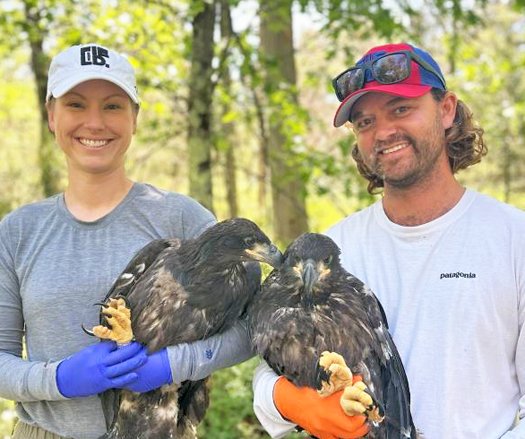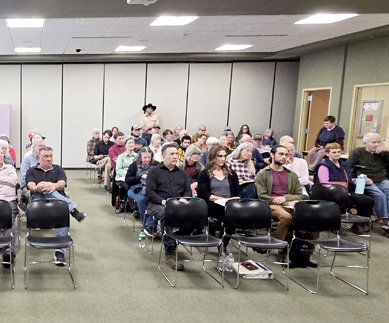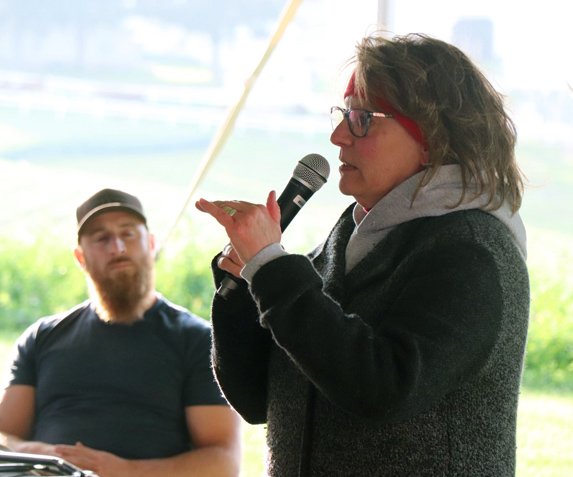Southwest Wisconsin’s state legislators sent a letter to Gov. Tony Evers requesting that Evers hold a listening session about the proposed Uplands Wind wind farm project in Lafayette and Iowa counties.
The letter was sent Monday, 10 days after a hearing at the Belmont Convention Center May 28 that drew unanimous opposition to the proposed project.
“Our listening session was well attended, with more than 100 residents who came to express concerns related to the project,” said the letter from Sen. Howard Marklein (R–Spring Green) and Reps. Travis Tranel (R–Cuba City) and Todd Novak (R–Dodgeville.) “You have long advocated for our state to be 100 percent carbon free by 2050. The renewable energy proposals planned to achieve this goal largely impact our rural communities who are often forced to live with the local effects of wind turbines. Unfortunately, policy decisions made in Madison are frequently implemented without communication with those whom the policy directly impacts.”
Neither Marklein’s nor Novak’s offices had received a response from Evers or his office as of Tuesday noon. The Platteville Journal also did not receive a response from Evers’ press office as of Tuesday noon.
The Uplands Wind Farm would be located in about 250 square miles of northwest Lafayette County and southwest Iowa County. The project would affect, in Lafayette County, Belmont and the towns of Belmont, Elk Grove, Willow Springs, Fayette, and Kendall. The project would spread throughout Iowa County into Cobb, Linden, Mineral Point, Dodgeville and the towns of Mifflin, Waldwick, Eden, Highland and Moscow.
Developer Pattern Energy is proposing 172 3.5-megawatt wind turbines that would be almost 700 feet tall producing a total of 600 megawatts.
The 98-megawatt Quilt Block Wind Farm turbines located in the Lafayette County Town of Seymour are 380 feet tall. The 30-megawatt Montfort Wind Energy Center along U.S. 18 between Montfort and Cobb has 320-foot-tall turbines. The height of the Uplands Wind turbines would be visible from the outskirts of Madison to the bluffs of the Mississippi River.
The project, scheduled to be built in 2023, is also fully dependent on building the Cardinal–Hickory Creek transmission line proposed to span western Grant, Iowa and Dane counties.
Participants at the Belmont event spoke to the legislators for an hour voicing their concerns over the project and its effects on property values, health issues and the aesthetic impact on the Driftless Area.
Event organizer and No-Uplands volunteer George Schwarzmann Jr. of the Town of Belmont voiced his issues with the Public Service Commission (PSC) and their lack of support for Wisconsin citizens.
“We have three pro-utility PSC commissioners with legislative control rubber-stamping any out-of-state or foreign industrial solar wind operation that wants to come here and set up house on our fertile seeded pristine Southwest Wisconsin, and we have no say in the matter,” he said.
Schwarzmann said Wisconsin has a declining need for electric generation and is also opposed to the Cardinal–Hickory Creek transmission lines. The PSC, Iowa Utilities Commission, U.S. Army Corps of Engineers and U.S. Fish and Wildlife Service approved the Cardinal–Hickory Creek project, but several lawsuits have been filed against that project.
“We are just supposed to sit back and let it happen,” he said. “The PSC should be working with us, not telling us what they’re going to do to us.”
Like many other speakers, Schwarzmann spoke of placing a moratorium on allowing wind turbine farms.
“The power is in your hands,” one citizen told the legislators.
Tranel said they don’t have quite as much power as everyone assumes they have but “ultimately we have to not only get our colleagues on board but we have to be able to talk to the governor.”
Tranel, Marklein and Novak noted how challenging it has been to be able to discuss with Evers any type of issues in the past year, which Tranel felt was “completely unacceptable”.
Marklein addressed how much technology has changed since the legislation was written in the early 2000s during Gov. James Doyle’s administration and because of that, the legislation should be looked over again.
Novak agreed with Marklein about how outdated the current laws are.
“Whoever dreamed 20 years ago we’d be sitting her talking about 700-foot windmills?” said Novak. He addressed this urban–rural divide these wind turbines are creating as the energy is being sent to bigger cities like Madison from the farmlands in the Driftless Area.
“Legislation is painfully slow,” said Marklein, who encouraged people to not give up, adding that if or when new legislation is drafted, they would need people to testify like they did that day.
Matt Johnson, field operations director for the Wisconsin Land and Liberty Coalition, said current energy regulations allow significant public input on projects, and said he does “not believe there should be any changes to the approval process of projects.”
“When projects have to be reviewed by the Wisconsin Public Service Commission they go through a rigorous process and a significant amount of studies are submitted to the PSC about the project,” he said.
Johnson added a moratorium would cause “significant economic damage to many rural areas of the state of Wisconsin. … Wind and solar projects require farmers and landowners to voluntarily lease their land for a utility scale project. These land lease payments can help farmers stay in business by providing guaranteed revenue for decades. With commodity prices that fluctuate the land lease payments can provide stable income.”
Wind projects also require hundreds of construction workers to construct the projects and long-term operations and maintenance staff to operate the project. Johnson said a moratorium would economically impact those rural communities workers would frequent for food, lodging and other commodities.
Johnson added that wind and solar projects are safe and economically benefit rural communities through land lease payments, construction and operating jobs, and shared revenue payments to local and county governments.
“Wind and solar power is often cheaper than power from coal plants,” he said. “The utilities and cooperatives in the state of Wisconsin want cheaper power from these projects because it will save them and their customers money over several decades. We are going to see more solar and wind projects in the state because it makes more financial and economic sense. Southwest Wisconsin will benefit greatly from wind and solar projects in the region.”





